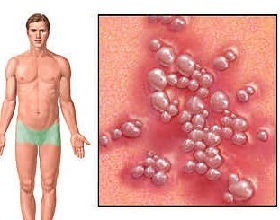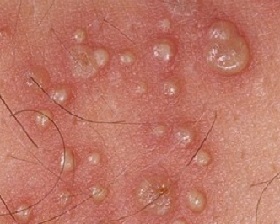 Genital or genital herpes refers to viral diseases. This disease is one of the most common among infections that are sexually transmitted.
Genital or genital herpes refers to viral diseases. This disease is one of the most common among infections that are sexually transmitted.
Among the world's population, 20% are carriers of this type of herpes, of which only 5% of the population has severe clinical signs, while the remaining 15% have no significant symptoms. Genital herpes occurs equally in women and men.
It is this ailment that causes changes in the human reproductive system: women are at increased risk of spontaneous miscarriages, intrauterine fetal death, it causes various diseases in newborns. There is an opinion that such diseases as cancer of the cervix and prostate gland in their etiology have the herpes virus.
Causes as transmitted
In most cases, the development of genital herpes leads to infection with the human herpesvirus virus of the second type (HHV-2). The cases of development of the disease caused by Herpes labialis - HHV-1 are also described. Infection with HHV-2 occurs mainly during sexual intercourse. A virus of the second type can be transmitted by kissing, when using shared dishes. Infection is also possible when using common hygiene items, towels and so on.
The source of herpetic infection is a person at any stage of the disease - with asymptomatic carrier and in the phase of rashes.
Main risk factors:
- unintelligibility in the choice of sexual partners;
- low standard of living;
- the virus is transmitted through kisses and the sharing of personal belongings (toothbrush, spoon);
- possible infection with oral-genital sexual contacts;
- possibly by infection with the herpes virus in the toilet.
Children can catch genital herpes airborne, contact-household (through objects contaminated with discharge of the sick person: saliva, urine), in utero (through the mother's blood). Infection of the child can occur while passing it through the infected birth canal of the mother during childbirth.
Genital herpes in men in most cases affects the genitourinary system, when women have a canal adjacent to the cervix. And often it has an asymptomatic course.
Symptoms of genital herpes in women and men
 In medical practice, several stages of the course of a viral infection are distinguished: primary sexual herpes, in which the problem manifests itself for the first time, and secondary - subsequent cases of ailment and relapses. In most cases, relapses are easier in comparison with the primary manifestation of genital herpes.
In medical practice, several stages of the course of a viral infection are distinguished: primary sexual herpes, in which the problem manifests itself for the first time, and secondary - subsequent cases of ailment and relapses. In most cases, relapses are easier in comparison with the primary manifestation of genital herpes.
The incubation period of primary genital herpes varies from 1 to 26 days (usually 2-10 days).
- The main symptoms of genital herpes are pain and swelling at the site of the lesion, burning occurs. All this can be accompanied by signs of intoxication: fever, general malaise, headache. After a few days on the external genitalia appear small bubbles, they are filled with a clear liquid. After a while, the vesicles burst and ulcers form in their place. Ulcers heal within 2 weeks of their formation.
- Recurrences of genital herpes are accompanied by similar symptoms, except for fever, headache and general malaise. The area of rashes is smaller and they heal faster. Relapse provokes any infectious diseases, hypothermia and emotional stress. Relapses can occur with different frequency from 2 times a month to 1 time per year. After the first episode, genital herpes can occur without visible clinical manifestations.
Primary genital herpes occurs predominantly in women in the form of vulvovaginitis, but the cervix can also be involved in the process. Primary herpetic vulvovaginitis is characterized by the appearance of pronounced edema and hyperemia of large and small labia, vaginal mucosa, crotch and, often, the inner thighs. There are pain, itching and dysuria, discharge from the vagina or urethra.
In men, primary elements are often located on the head, the body of the penis, the neck of the head, the scrotum, thighs and buttocks. Grouped bubbles appear first with a clear, and then cloudy content. After the opening of the vesicles, extensive erectile erosions are formed, having a round shape. Fusing, they form extensive ulcers with a wet surface. Defects of the epithelium heal in 2-4 weeks, leaving behind hyperpigmented spots. Scars usually do not happen.
What does genital herpes look like?
In the photo below you can see what the disease looks like for men or women.
Complications
Possible consequences of this disease include:
- Retention of urine.
- Secondary infectious complications caused by skin pathogenic microorganisms (creeping phlegmon).
- Formation of adhesions in the labia.
- Severe pain syndrome.
- Infection of the fetus during pregnancy.
Diagnostics
Modern clinical laboratory diagnostics are carried out by ELISA methods (blood, tear, cerebrospinal fluid, amniotic fluid) and PCR (any biological material).
Methods of PIF, RNIF, "detection of the virus antigen", "characteristic inclusions" are erroneous.
With chronic HSV infection, the detection of antibodies only confirms the fact of chronic infection, but does not reflect the activity of the virus and does not confirm the association of this infection with the emerging rashes. The activity of the virus, the threat to the fetus, the indications for treatment during pregnancy and the effectiveness of the treatment performed are determined by the method PCR-studies of the blood of a woman and / or amniotic fluid and other materials obtained in the study of the tissue of the fetus or placenta.
How to treat genital herpes
 Modern possibilities of medicine do not allow completely cure the herpes simplex virus. Outside relapse (reappearance), the virus is in an inactive state. With the weakening of immunity, a recurrence of genital herpes occurs. Treatment accelerates the healing of rashes, reduces the risk of recurrence and reduces the excretion of the pathogen, but can not completely destroy the virus.
Modern possibilities of medicine do not allow completely cure the herpes simplex virus. Outside relapse (reappearance), the virus is in an inactive state. With the weakening of immunity, a recurrence of genital herpes occurs. Treatment accelerates the healing of rashes, reduces the risk of recurrence and reduces the excretion of the pathogen, but can not completely destroy the virus.
In the case of genital herpes, the treatment regimen is divided into two main types:
- Conducting antiviral therapy: the effectiveness of treatment reaches 80 percent; treatment is based on such medicinal drugs that contain ACV (acyclovir), for example, acyclovir-acry and zovirax; there are different forms of release of these drugs (tablets, ointments, solution for injections intravenously); the group of ACV-containing drugs is sometimes replaced with triapentene or alpizarin;
- Conducting immunotherapy in parallel with antiviral therapy (aimed at correcting the links of immunity, specific and nonspecific).
In general, how to treat genital herpes determines the frequency of relapses and the severity of clinical symptoms, the state of the immune system system, the risk of transmitting an infection to a sexual partner or a newborn, and the psychosocial consequences of infection.
With ineffective therapy, complications may develop. In most cases, genital herpes is transformed into a chronic form with periodic recurrences of the process.
General recommendations
All patients who have genital herpes and their sexual partners should be aware of the recurring nature of the disease and during the period of rashes, abstain from sexual activity.
In the case of contacts, a condom should be used. Sexual partners should be examined and, if they have GG, to undergo treatment. Subsequent counseling of patients with this disease is an important stage in the management of patients.

How to choose probiotics for the intestine: a list of drugs.

Effective and inexpensive cough syrups for children and adults.

Modern non-steroidal anti-inflammatory drugs.

Review of tablets from the increased pressure of the new generation.
 Antiviral drugs are inexpensive and effective.
Antiviral drugs are inexpensive and effective.



